Toy Story is a 1995 American computer-animated film produced by Pixar Animation Studios and directed by John Lasseter for Walt Disney Pictures.

Image source: https://en.wikipedia.org/wiki/Toy_Story#/media/File:Toy_Story.jpg
The movie is set in a world where anthropomorphic toys pretend to be lifeless whenever humans are present, the film’s plot focuses on the relationship between Woody, an old-fashioned pullstring cowboy doll (voiced by Tom Hanks), and Buzz Lightyear, an astronaut action figure (voiced by Tim Allen), as they evolve from rivals competing for the affections of Andy, their owner, to friends who work together to be reunited with Andy as his family prepares to move to a new home.
Toy Story was the first feature-length computer-animated film and the first film created by Pixar.
It set a benchmark in terms of animation to which other film companies have since aspired.
When the first Pixar feature, Toy Story, was released in 1995, the animated genre saw a new dawn. Not only did it introduce the world to computer-generated animation but it also showed the capacity for humanity and emotion that director John Lasseter and the rest of the team brought to the animated film.
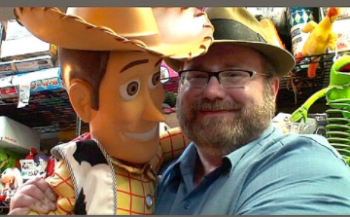
Image source: https://search.creativecommons.org/photos/137b5df0-05ac-4c87-9967-cb399784c8ad by JeepersMedia
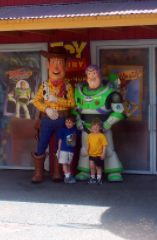
Image source: https://search.creativecommons.org/photos/9cfaf2c4-d63e-4c11-ad3e-3396539446dd by wwarby
Toy Story was technically at the top of its game, while also illustrating some very familiar thematic through lines that included the rivalry between Woody and Buzz Lightyear, the buddy comedy, the fear that we all have of becoming obsolete, and of course the very idea of toys having a life of their own. The result was a huge success and created the cinematic superpower known as Pixar along the way.
Info source: http://pixar-animation.weebly.com/toy-story.html
John Lasseter and the Development of Toy Story
John Lasseter is an American animator widely credited with engineering the success of Pixar Animation Studios through a synthesis of cutting-edge computer animation and classic storytelling.
He attended the California Institute of the Arts, which had just begun offering animation courses taught by veteran Disney artists. After graduation (1979) he took a job at Disney’s animation studio, where he worked on The Fox and the Hound (1981) and Mickey’s Christmas Carol (1983). His enthusiasm for nascent computer animation technology put Lasseter at odds with some of his superiors and he was fired in 1983.
By the following year Lasseter had been hired to work in the computer graphics division of Lucasfilm Ltd. In 1986 the division was acquired by Apple Computer, Inc., cofounder Steve Jobs and became an independent company called Pixar that focused primarily on developing and selling animation software.
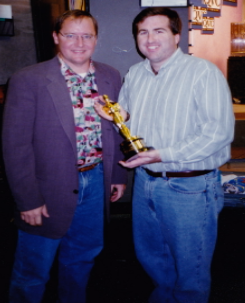
Image source: https://en.wikipedia.org/wiki/Toy_Story#/media/File:John_Lasseter,_Jim_Breslin,_1996_(crop).jpg
Pixar also produced television commercials and short films, with Lasseter serving as director. Tin Toy (1988) earned Lasseter an Academy Award for best short animated film.
Tin Toy gained Disney’s attention, and the new team at The Walt Disney Company, CEO Michael Eisner and chairman Jeffrey Katzenberg in the film division, began a quest to get Lasseter to come back. Lasseter, grateful for Jobs’ faith in him, felt compelled to stay with Pixar, telling co-founder Ed Catmull,
“I can go to Disney and be a director, or I can stay here and make history.”
Katzenberg realized he could not lure Lasseter back to Disney and therefore set plans into motion to ink a production deal with Pixar to produce a film. Disney had always made all their movies in-house and refused to change this. But when Tim Burton, who used to work at Disney, wanted to buy back the rights to The Nightmare Before Christmas, Disney struck a deal allowing him to make it as a Disney movie outside the studio. This opened the door for Pixar to make their movies outside Disney.
Lasseter directed the initial effort, Toy Story. It became the highest-grossing film of 1995 and earned him a second Academy Award, this time for special achievement. Lasseter went on to direct other successful Pixar films for Disney—namely, A Bug’s Life (1998) and Toy Story 2 (1999). He codirected Cars (2006). During that time Lasseter also produced such Pixar films as Monsters, Inc. (2001) and Finding Nemo (2003).
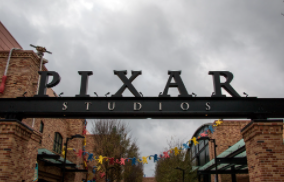
Image source: https://search.creativecommons.org/photos/8b6950b8-40dc-4a5f-9a9e-3611f2e246c2 by HarshLight
Lasseter returned to the company that had fired him when Disney purchased Pixar in 2006. He was named chief creative officer of both Pixar’s and Disney’s animation operations, and in that capacity he produced numerous features, including Up (2009), the third installment in the Toy Story franchise (2010) and Inside Out (2015).
Info source: https://www.britannica.com/biography/John-Lasseter#ref1092012
Animation
Lasseter said that on the challenges of the computer animation in the film “We had to make things look more organic. Every leaf and blade of grass had to be created. We had to give the world a sense of history. So the doors are banged up, the floors have scuffs.”
The film began with animated storyboards to guide the animators in developing the characters. 27 animators worked on the film, using 400 computer models to animate the characters. Each character was either created out of clay or was first modeled off of a computer-drawn diagram before reaching the computer animated design. Once the animators had a model, articulation and motion controls were coded; this would allow each character to move in a variety of ways, such as talking, walking, or jumping.
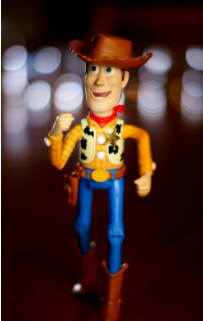
Image source:https://search.creatiecommons.org/photos/12bd51e0-9624-4278-b5da-feab3fe8d1f8 by Tom Newby Photography
Out of all the characters, Woody was the most complex, as he required 723 motion controls, including 212 for his face and 58 for his mouth. The first piece of animation, a 30-second test, was delivered to Disney in June 1992, when the company requested a sample of what the film would look like.
Lasseter wanted to impress Disney with a number of things in the test that could not be done in traditional, hand-drawn animation, such as Woody’s yellow plaid shirt with red stripes, the reflections in Buzz’s helmet and the decals on his space suit, or Venetian blind shadows falling across Andy’s room.
Info source: https://en.wikipedia.org/wiki/Toy_Story
“To Infinity and Beyond”
Toy Story has received universal critical acclaim
since its release in 1995. Time named it the 8th best film of 1995. In 2003 it was ranked ‘the greatest animated movie of all time’ by the Online Film Critics Society.
Toy Story was the number one movie of the year in 1995 (beating Batman Forever and Apollo 13), according to Box Office Mojo. It opened the day before Thanksgiving and made almost $10 million on Wednesday and Thursday, plus another $29 million over the weekend. It was the number one film for its first 3 weekends, and then again the last weekend of December. During its theatrical run it grossed $191.8 million domestically and $362 million worldwide. At the time it was the third highest-grossing animated film, behind The Lion King and Aladdin.
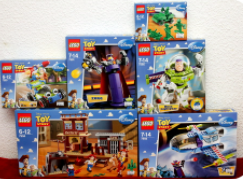
Image source: https://search.creativecommons.org/photos/18d41d0c-0cb8-435c-a16c-0f37fae1ba36 by pasukaru76
Toy Story had a large impact on the film industry with its innovative computer animation. After the film’s debut, various industries were interested in the technology used for the film. Graphics chip makers desired to compute imagery similar to the film’s animation for personal computers; game developers wanted to learn how to replicate the animation for video games; and robotics researchers were interested in building artificial intelligence into their machines that compared to the film’s lifelike characters.
Info source: http://pixar.wikia.com/wiki/Toy_Story
https://en.wikipedia.org/wiki/Toy_Story
https://www.telegraph.co.uk/film/what-to-watch/pixar-history-good-dinosaur-toy-story/
